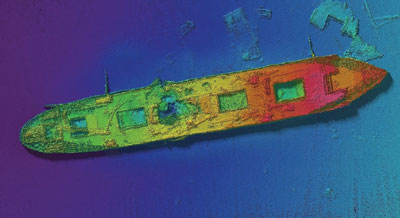| 2006 |

|
YEAR BOOK |
University of Ulster
|
Exploring inner space: mapping seabed habitats using acoustic techniques
|

A wide variety of acoustic systems are available which provide data relating to bathymetry or seabed texture, with the choice of system depending on the objectives of the survey. Many of the current acoustic systems have a proven record of measuring and imaging geological properties associated with the seafloor. Their use in studying benthic ecosystems on the other hand is a relatively new field, and interest is high in assessing their suitability for seabed habitat mapping.
Research at the Centre for Coastal and Marine Research (CCMR) is focusing on how a number of these acoustic survey techniques (e.g. multibeam sonar, sidescan sonar and single beam acoustic ground discrimination systems) can be used for the identification and mapping of the marine biological component of the seabed, or benthic habitat. This developing area of research offers ways to revolutionise the way we study the seabed environment and has the potential to dramatically improve our understanding of seafloor ecosystems. A particular focus of the research is the use of acoustic backscatter data for habitat discrimination. Backscatter data provides an indication of the seabed characteristics (e.g. hardness, roughness, biological component etc.) and is proving useful in delineating different seabed habitat types. The findings of the research are of value to a wide range of organizations involved in the management and conservation of the UK's marine environment. For details of current research projects underway at the CCMR visit the CCMR website.
Contact: Dr Craig Brown,
Centre for Coastal and Marine Research,
School of Environmental Sciences,
University of Ulster, Cromore Road, Coleraine, Co. Londonderry, BT52 1SA
Tel: +44 (0)2870 323337
E-mail: [email protected]
Website: http://www.science.ulster.ac.uk/ccmr/mapping.html